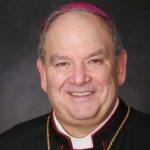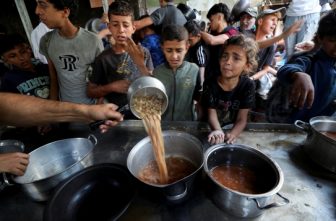Our archdiocese has been deeply blessed in this month dedicated to the missions by the presence of the relics of St. Thérèse of Lisieux, universal patroness of the foreign missions, and her saintly parents, Sts. Zélie and Louis Martin.
I felt so privileged to preside at two events in our Cathedral on the evening of Oct. 6 as thousands of our brothers and sisters came forward, often with their little children, to give thanks and praise to God and to venerate the relics of these great saints. The lines were seemingly endless and visually reminded me of the great diversity in this local Church, with significant representation that evening from our Latino, Asian and African communities.

It brought back memories of the last time that I had prayed before the reliquary with St. Thérèse’s earthly remains. The Holy See had brought the relics of the Little Flower to St. Peter’s Square on Oct. 19, 1997, as St. John Paul II declared St. Thérèse to be a doctor of the Church, an amazing accomplishment for someone who had had no formal theological education. The liturgy that day — World Mission Sunday — involved groups from around the globe, all feeling a particular closeness to this saint even though she had never ventured out of her monastery once she professed her vows as a cloistered Carmelite. I will never forget the emotion that was communicated in the chanting of a Maronite choir that day.
In June of this year, as part of the worldwide celebrations for the 150th anniversary of Thérèse’s birth and the 100th anniversary of her beatification, the relics returned to St. Peter’s Square. Providentially, Pope Francis was able to pray with the relics just before going into the hospital for his most recent surgery.
The presence of the relics at the Vatican gave the Holy Father an opportunity to reflect on the missionary dimension of the life of the Little Flower, who had been declared the patron saint of the missions by his predecessor, Pope Pius XI, in 1927. Pope Francis noted that “… though her body was sickly, her heart was vibrant, missionary. She recounts in her ‘diary’” that her desire was that of being a missionary, and that she wanted to be one not just for a few years, but for the rest of her life, even until the end of the world. St. Thérèse was a “spiritual sister” to several missionaries; she accompanied them from her monastery through her letters, through her prayer, and by offering continuous sacrifices for them. Without being visible, she interceded for the missions, like an engine that, although hidden, gives a vehicle the power to move forward.
The work of the missions, so dear to the heart of St. Thérèse, is as important in 2023 as it was in her day. Pope Francis reminds us that missionaries are “not only those who travel long distances, learn new languages, do good works, and are good at proclamation; no, a missionary is anyone who lives as an instrument of God’s love where they are. Missionaries are those who do everything so that, through their witness, their prayer, their intercession, Jesus might pass by.”
As we gathered before the relics in the Cathedral, I felt privileged to be able to pray for Father Greg Schaffer, one of our archdiocesan priests, who leads the parish that our archdiocese supports in Venezuela, as well as for our sisters and brothers in Kitui, Kenya, and for the many missionaries from our archdiocese, including those featured in this week’s Catholic Spirit.
Like the Little Flower, we are called to not only intercede for the missions through our prayers but also to support them with our sacrifices. I’m always edified by the generosity of the faithful of this archdiocese in supporting the Church’s missionary efforts.
While we are always called to keep the missions in our prayers, the Church dedicates one Sunday each year as World Mission Sunday and asks us in particular on that occasion to support the Pontifical Mission Societies. The funds collected that weekend, this year Oct. 21 and 22, will enable those societies to provide annual subsidies to over 1,100 missionary dioceses in their proclamation of the Gospel, and to directly support mission seminaries and religious formation houses, the education of children in mission schools, the building of chapels and churches, as well as sustaining homes for orphaned children, the elderly and the sick.
When the Pontifical Mission Societies were first formed, the young Church in the United States benefited greatly from their prayers and generosity. Now it is our turn to support as best we can the Church’s missionary efforts. I hope that you will join me in praying for the success of this year’s World Mission Sunday.




